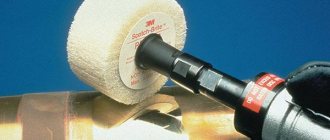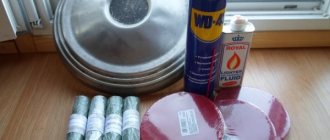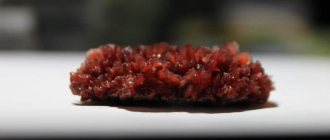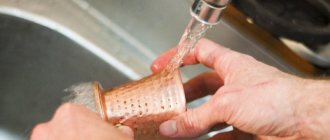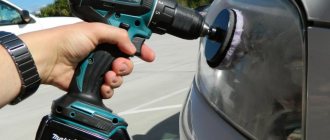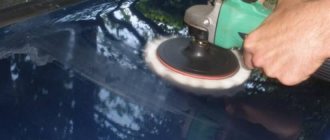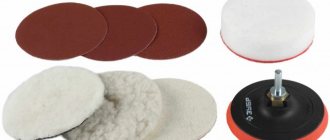Definition of the concept of “polishing” and its types
Polishing metal using an angle grinder
Polishing is a type of metal processing, during which the shine is restored to the metal surface. At the present stage, the following grinding methods are distinguished:
- Manual polishing - is carried out mainly during repair work;
- Semi-mechanical polishing - using special polishing wheels worn
Felt polishing discs for polishing metal
on a polishing machine; - Machine method - used in large enterprises. The metal surface is processed by a polishing machine;
- Water jet grinding on special machines. This technology is used only for processing large volumes of products. Plasma and chemical-mechanical polishing work on the same principle.
What tools and machines are used? Mechanical methods involve the use of the following tools and devices:
- polishing machine;
- Grinder;
- electric sharpener;
- drills with clamps.
This finishing method has several advantages. Firstly, it allows you to change the rotation frequency of circles and belts, which has a positive effect on the quality of processing of the metal plane; secondly, additional attachments made of fabric, leather, wool, etc. can be installed on the polishing machine.
Special grinding machine - angle grinder
Manual grinding differs from automated grinding in that its effectiveness depends on the quality of consumable polishing materials. In manual finishing, diamond paste and additives based on chromium or iron oxide are used. Smooth metal surfaces are polished with an ordinary file - a wooden block covered with a cloth, onto which polishing paste is applied.
Polishing metal with a special device
Abrasive stones
Stones, like paper, come in different grain sizes. The most popular are 320,400 and 600 units. For proper grinding, experts recommend using Indian bench stones. This method has been used for a long time.
Stones are good for removing unevenness from metal. In the old days, sand and soil were used for these purposes. And for polishing, stones with a structure harder than the blade were used. The most popular stone for polishing is sandstone.
Combined processing methods
Metal polishing can be carried out using combined methods, in the case of an unprepared and rough surface with rough relief. In this case, a long-term electrolyte-plasma finishing is prescribed, which consists of removing a significant layer of metal.
This processing method is used in extreme cases when quick restoration of the shine of a metal product is required. Among the disadvantages of the technology, one should highlight the high energy intensity, especially at the initial stage of processing, when 100% more energy is used than usual.
Electrolytic plasma polishing machine
An electrolytic plasma polishing machine processes the part in two stages. At the first, the surface is degreased, and at the second, the grinding itself occurs, which, in turn, also consists of two cycles: cutting off the rough layer and grinding the metal. Cleaning from grease is mandatory, since a viscous surface leads to oxidation of the metal and deterioration in the quality of its finish.
Chemical polishing
During chemical polishing, the surface is exposed to a combination of a specific substance and galvanic fumes. This process determines the formation of a passivating oxide film, which leads to the leveling of surface microroughness.
The quality of polishing depends on the ratio of the rate of film formation and its dissolution in the liquid. The highest gloss can be achieved by forming a thin film. With chemical polishing of metal, it is possible to achieve a film of thinner thickness than with electrochemical polishing, which determines the possibility of achieving better shine, but large irregularities in the part cannot be leveled out.
Electrochemical polishing
Classification of metal polishing pastes
You can bring a metal surface to a mirror state with your own hands without the use of machines; just pay attention to special tools, divided into the following groups:
Types of polishing pastes
- Aquatic. The substance does not contain fat and does its job perfectly;
- Organic products contain paraffin and various oils. They are diluted with various oils and fatty acids;
- Diamond paste is a revolutionary solution that allows you to instantly achieve shine on any metal surface.
Let's take a closer look at the last version of grinding. Diamond paste is so effective that it completely replaces a polishing machine. Diamond Substance is available in two types: ASN and ASM brands (expensive).
Metal polishing paste
Diamond paste has the following advantages:
- Accuracy. Synthetic diamonds allow you to polish any metal product to a shine as accurately as possible;
- Wide range of grain sizes. There are more than 12 grit types available on the market today;
- Simple operation allows you to carry out cleaning procedures yourself without the use of special tools;
- Diamond paste requires minimal tools: a rag, water and rubber gloves.
Table of metal polishes
The main disadvantage of the cleaning product in question is its high price. On average, diamond paste on the consumables market costs more than 500 rubles per 35 grams of the substance.
Working principle of diamond paste
Diamond paste acts on a metal product mechanically and chemically, forming dispersed films. The cleaning agent contains active substances that promote adsorbing processes, which facilitates grinding of the material.
Diamond paste can be of different components
Diamond paste is applied to different types of fabrics (felt, microfiber or jeans), paper, rubber, plastic and other types of non-metallic materials. It is worth noting that diamond paste can also be applied to polishing wheels to increase the efficiency of metal surface processing. In this way you can achieve a mirror effect. Circles made of felt, felt or leather are installed on the polishing machine.
Preparatory stages
Industrial enterprises that engage in various types of metal processing check the condition of surfaces before grinding begins. Before using various chemical reagents and polishing machines, the part must be prepared for further stages of polishing; for this, the product is affected by one of the mechanical methods:
- processing the part with compressed air together with special coarse abrasive elements that remove large build-ups of corrosion and rust from the surface;
- cleaning the surface of the product with brushes with stiff bristles to remove signs of oxidation and sludge (dust formed as a result of cleaning with a coarse abrasive);
- degreasing surfaces from traces of previous polishing agents by treating with warm organic solvents;
- the use of alkaline solutions to remove residual mineral substances containing oil;
- electrochemical degreasing (immersion of a metal product in an electrolyte).
All these methods are most often used in industrial production conditions. At home, to prepare a metal product for polishing, it is enough to treat the surface with sandpaper of varying hardness.
Description of the polishing process
To grind a metal surface you will need: laps and several tubes of diamond mixture with different grits. Diamond paste is evenly distributed over the working surface of a rag or other material. Experts have noticed an interesting pattern that makes it possible to improve the quality of metal processing.
Sanding metal parts
It turns out that you need to add castor or olive oil to the polishing substance. The ideal ratio is considered to be a mixture consisting of 40% diamond dust and 60% oil. After dilution, the mixture is immediately applied to the metal surface.
Related abrasive tools and grinding methods
Experts recommend starting to work only with large grains, gradually moving on to abrasives. During processing, make sure that no unnecessary elements get into the mixture - dust, sawdust, hair or pieces of rags. The presence of foreign objects greatly impairs the polishing to a shine. It is also recommended to wash your hands after changing from one grit to another.
Result
Grinding and polishing metal at home, carried out in compliance with all technical requirements, can completely restore the appearance of a metal object. With minimal financial costs and a certain skill, you can achieve high results.
If you need to compare your work with the ideal result, you can always watch a video on the Internet - “Grinding and polishing metal at home”, where you can find lessons on various polishing methods. They tell in detail about all the nuances of polishing metals at home.
Types of Diamond Dust
On the modern market you can find products not only for polishing metal, but also other materials, for example, wood, glass, stone, etc. They can be classified by color, for example:
Huge range of diamond paste
- Yellow packaging indicates that the substance is intended for grinding ceramic materials and glass products. It is worth noting that this dust can also be used for finishing metal;
- Blue packaging. This type of product is used for finishing glass. The grinding agent has a fairly wide selection of abrasive elements - from 60 to 10 levels;
- The red packaging is suitable exclusively for treating metal surfaces.
As for the packaging itself, diamond paste is sold in compact plastic jars with a volume of 35–45 grams. The average cost of a jar depends on the size and quality of abrasive materials. The finer and higher quality the polishing material, the cheaper the paste costs. The average price is 450–600 rubles.
Paste GOI
GOI chrome paste is a universal product used for polishing metal and non-metallic surfaces. Although it was invented in the early 1930s, it is still used to polish metals today.
Polishing paste GOI
The GOI product comes in different grain sizes (classified according to the size of the abrasive materials). There are different types of grain size: fine, medium, and coarse. Fine dust is used for polishing soft and non-ferrous metals, coarse grains are used for rough finishing of ferrous metals and steel.
Features of use. Initially, the polishing agent has a solid structure, which can be diluted with a few drops of machine oil. If you need to polish an uneven metal surface with bends, it is recommended to apply the paste diluted on a rag.
Polishing with GOI paste
The second polishing method is intended for processing smooth metal surfaces. Its peculiarity is that a small amount of abrasive material is applied to a wooden block. Then it is recommended to make methodical movements back and forth along the surface being treated.
For manual grinding, it is recommended to use soft types of fabrics - cotton or flannel; for ferrous metals, denim or canvas fabric is suitable.
Safety precautions
When using a chemical polishing method, be sure to use special gloves, respiratory protection, and special utensils that do not react with acid. Polishing metal to a mirror shine with a grinder or drill should be carried out using eye protection. And most importantly, you must strictly adhere to the technological process. It is necessary to always have a medical first aid kit on hand, with which you can provide first aid before the arrival of the ambulance, although it is advisable to prevent such cases.
